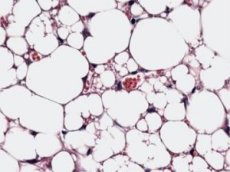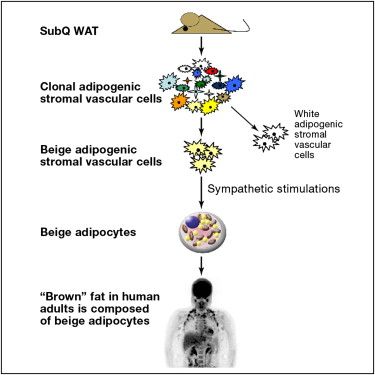Medical expert of the article
New publications
Beige fat cells can help fight obesity
Last reviewed: 01.07.2025

All iLive content is medically reviewed or fact checked to ensure as much factual accuracy as possible.
We have strict sourcing guidelines and only link to reputable media sites, academic research institutions and, whenever possible, medically peer reviewed studies. Note that the numbers in parentheses ([1], [2], etc.) are clickable links to these studies.
If you feel that any of our content is inaccurate, out-of-date, or otherwise questionable, please select it and press Ctrl + Enter.

Scientists at the Dana-Farber Cancer Institute have isolated a new type of energy-burning fat cell that grows in adult white fat stores. They believe these cells could be the basis for new, effective treatments for obesity.
In adults, these so-called beige fat cells are found near the collarbone and along the spine in pea-sized depots scattered under the skin. Because this type of fat burns calories—rather than storing them, as white fat cells do—it could help develop new treatments for obesity and diabetes, according to study leader Bruce Spiegelman, PhD, and colleagues.
Dr. Spiegelman is the lead author of the paper published in the journal Cell.
The study found that beige fat is genetically distinct from “brown fat,” which also burns calories to generate heat. Brown fat is found in baby mammals and infants, where it protects them from the cold. In contrast, white fat stores calories, and too much of it contributes to obesity.
The possibility of this third type of fat (in addition to white and brown) was predicted by Dr. Spiegelman in 2008, but the Dana-Farber Cancer Institute team is the first to isolate these cells and determine their unique genetic profile. In a new paper, Dr. Spiegelman and colleagues report that beige fat cells are a specific target of the hormone irisin, which is expressed by muscle cells during exercise.

In 2009, three research groups reported finding brown fat stores in adult humans, but Spiegelman's latest work, based on the genetic profile of the cells, identifies them as beige fat.
Even in small amounts, brown and beige fat can burn a lot of calories.
Brown fat produces heat via the mitochondrial uncoupling protein UCP1, protecting the body from hypothermia and obesity. Recent evidence suggests that there are two distinct types of brown fat: classic brown fat, derived from a myf-5 cell line, and UCP1-positive cells, which arise in white fat from a non-myf-5 line. Scientists at the Dana-Farber Cancer Institute have isolated beige cells from the white fat depot of mice. Beige fat cells resemble white fat cells in that they have extremely low basal UCP1 expression, but like classic brown fat, they respond to cyclic AMP stimulation with high UCP1 expression and increased respiration. The gene expression pattern of beige cells is distinct from that of either white or brown fat, and these cells are preferentially responsive to the polypeptide hormone irisin. The researchers provided compelling evidence that previously identified brown fat depots in the adult human body consist of beige adipocytes.
"The therapeutic potential of both of these fat cell types is clear," the authors write in Cell, "as genetic manipulation of mouse cells to produce more brown or beige fat has been shown to successfully combat obesity and diabetes."
Scientists are already looking for ways to use brown fat for human benefit.
Both brown and beige fat cells contain energy-burning organelles called mitochondria, which contain iron, giving these tissues their brown and beige colors. The main difference is that brown fat cells express high levels of UCP1, a protein needed by mitochondria to burn calories and produce heat, while beige cells normally have low basal levels of UCP1. However, beige cells can increase their UCP1 production in response to cold or certain hormones like irisin, allowing beige fat to burn calories almost as efficiently as brown fat.
Dr. Spiegelman made a number of discoveries about the different types of fat cells. He found that brown fat cells originate from the stem cells that give rise to muscle cells. Beige fat cells, on the other hand, originate in white fat from the precursors of beige cells.
Earlier this year, Spiegelman announced the discovery of a hormone called irisin, which is produced by muscle cells during exercise and transforms white fat into brown fat. In a new paper in Cell, Spiegelman reports that irisin specifically stimulates white fat to produce beige fat. Dana-Farber Cancer Institute has licensed both discoveries to Spiegelman's biotech company, Ember Therapeutics, which plans to develop irisin into a drug to treat obesity and diabetes.


 [
[